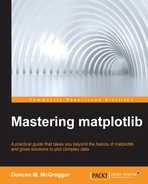Book Description
A practical guide that takes you beyond the basics of matplotlib and gives solutions to plot complex data
- Customize, configure, and handle events, and interact with figures using matplotlib
- Create highly intricate and complicated graphs using matplotlib
- Explore matplotlib's depths through examples and explanations in IPython notebooks
In Detail
matplotlib is a Python plotting library that provides a large feature set for a multitude of platforms. Given the depth of the library's legacy and the variety of related open source projects, gaining expert knowledge can be a time-consuming and often confusing process.
You'll begin your exciting journey learning about the skills that are necessary in leading technical teams for a visualization project or to become a matplotlib contributor.
Supported by highly-detailed IPython Notebooks, this book takes you through the conceptual components underlying the library and then provides a detailed overview of its APIs. From there, you will learn about event handling and how to code for interactive plots.
Next you will move on to customization techniques, local configuration of matplotib, and then deployments in Cloud environments. The adventure culminates in an exploration of big data visualization and matplotlib clustering.
What You Will Learn
- Analyze the matplotlib code base and its internals
- Re-render visualized data on the fly based on changes in the user interface
- Take advantage of sophisticated third-party libraries to plot complex data relationships
- Create custom styles for use in specialize publications, presentations, or online media
- Generate consolidated master plots comprising many subplots for dashboard-like results
- Deploy matplotlib in Cloud environments
- Utilize matplotlib in big data projects
Downloading the example code for this book You can download the example code files for all Packt books you have purchased from your account at http://www.PacktPub.com. If you purchased this book elsewhere, you can visit http://www.PacktPub.com/support and register to have the files e-mailed directly to you.
Table of Contents
- Mastering matplotlib
- Table of Contents
- Mastering matplotlib
- Credits
- About the Author
- About the Reviewers
- www.PacktPub.com
- Preface
- 1. Getting Up to Speed
- 2. The matplotlib Architecture
- 3. matplotlib APIs and Integrations
- 4. Event Handling and Interactive Plots
- 5. High-level Plotting and Data Analysis
- 6. Customization and Configuration
- 7. Deploying matplotlib in Cloud Environments
- 8. matplotlib and Big Data
- 9. Clustering for matplotlib
- Index
